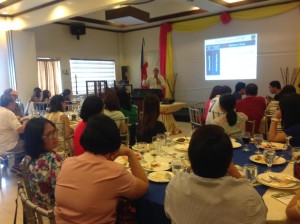 In 2011, the Philippines achieved the Millennium Developmental Goals (MDG) for tuberculosis. The Post 2015 Global Strategy Framework for TB aims to achieve the following Goals for 2025 compared to 2015: 75% reduction of deaths from tuberculosis, a 50% reduction of the incidence of tuberculosis and there being no affected families facing catastrophic costs due to tuberculosis.
In 2011, the Philippines achieved the Millennium Developmental Goals (MDG) for tuberculosis. The Post 2015 Global Strategy Framework for TB aims to achieve the following Goals for 2025 compared to 2015: 75% reduction of deaths from tuberculosis, a 50% reduction of the incidence of tuberculosis and there being no affected families facing catastrophic costs due to tuberculosis.
Amongst the Pillars and Components of the Framework is the engagement of communities, civil society organizations and public and private care providers. The contribution of the private sector in the case finding of tuberculosis with the public-private mix DOTS (PPMD) is a significant 11%.
To achieve the goals for a TB Free Philippines and World, it would be important that the private sector continues to be involved in the fight against tuberculosis.
On April 9, 2015 in an activity sponsored by Pfizer Philippines, I gave a talk to a group of 35 physicians, mostly Family Physicians, Consultants and some Residents in Tagum, Davao del Norte. This was on the latest International Standards of Tuberculosis Care (ISTC 3rd ed. 2014) and The Manual of Procedures (MOP 5th ed. 2014) of the National Tuberculosis Program (NTP).
We looked at recent Philippine Data on Tuberculosis, changes in the most recent ISTC and MOP and how they complement each other.
The latest edition of the ISTC highlights the role of rapid molecular testing (XpertMTB/RIF) for the diagnosis of tuberculosis. This has the potential for providing a confirmed diagnosis and determination of Rifampicin resistance within 2 hours leading to early treatment and a reduction in the spread of infection.
Rapid molecular testing is presently recommended by the NTP for presumptive drug resistant tuberculosis and people living with HIV (PLHIV) with signs and symptoms suggestive of tuberculosis. This test is now available in the Region at these centers: Davao TB Reference Lab (DOH Compound), Davao Chest Center, Davao Regional Hospital, Mati City health Office and Malita Rural Health Unit.
Aside from rapid diagnosis, additional important changes in the ISTC include: emphasis on the recognition of groups at increased risk of tuberculosis, an update on the use of antiretroviral treatment in persons with concomitant TB and HIV infection and a revision of the standard on the treatment of drug resistant tuberculosis.
The attendees were given printed copies of the ISTC for their reference. The latest edition of the ISTC can be downloaded free in PDF format from the following website: https://www.istcweb.org/Home.html
In the control of Tuberculosis, everyone is responsible!

